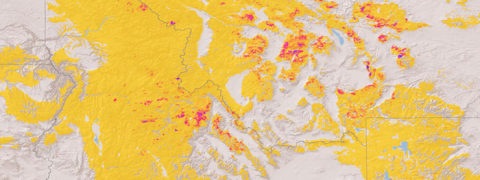Tree mortality from disturbances such as fires and bark beetles can have important impacts on the carbon cycle. A new paper by Logan Berner and colleagues quantified the carbon stored in trees killed by these disturbances and mapped their distribution throughout the western US (Berner et al 2017).
In 2012, moderate-to-exceptional drought affected the most extensive area in the history of the U.S. Drought Monitor (NOAA NCEI). Millions of forested acres in the United States have been affected by bark beetles. By killing trees, bark beetle outbreaks can significantly influence forest carbon storage and cycling. At the same time, current research shows that warming summer and winter temperatures are driving beetle population outbreaks in susceptible forests, and allowing these insects to persist in habitats previously constrained by cold temperatures (US Forest Service). Quantifying the amount of carbon stored in trees killed by disturbance can help inform decisions about managing greenhouse gas emission targets.
The ORNL DAAC recently published the Berner et al. dataset that quantifies mean annual tree mortality from fires, bark beetles, and timber harvest from 2003–2012 for each state in this region.
Tree Mortality from Fires and Bark Beetles at 1-km Resolution, Western USA, 2003-2012
This data set provides annual estimates of tree mortality due to fires and bark beetles from 2003 to 2012 on forestland in the continental western United States. Tree mortality was estimated at 1-km spatial resolution by combining tree aboveground carbon (AGC) and disturbance data sets derived largely from remote sensing. Tree mortality is expressed as the amount of AGC stored in trees killed by disturbance (Mg carbon per km2). The data set also includes annual uncertainty maps that were generated using a Monte Carlo approach in which tree biomass, biomass carbon content, and disturbance severity were iteratively varied by their uncertainty.
Data Citation
Berner, L.T., B.E. Law, A.J. Meddens, and J.A. Hicke. 2017. Tree Mortality from Fires and Bark Beetles at 1-km Resolution, Western USA, 2003-2012. ORNL DAAC, Oak Ridge, Tennessee, USA. http://dx.doi.org/10.3334/ORNLDAAC/1512
Read more:
Berner, L. T., B. E. Law, A. J. Meddens, and J. A. Hicke. 2017. Tree mortality from fires, bark beetles, and timber harvest during a hot and dry decade in the western United States (2003–2012), Environmental Research Letters 12(6), 065005. https://doi.org/10.1088/1748-9326/aa6f94
NOAA National Center for Environmental Information. https://www.ncdc.noaa.gov/sotc/drought/201206
US Forest Service. https://www.fs.usda.gov/ccrc/topics/bark-beetles-and-climate-change-uni…


